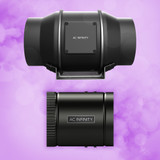The Differences Between Inline Duct Fans & Duct Fan Boosters

Two duct fans that often come up in Amazon searches are inline duct fans and duct fan boosters. At a glance they appear and work similarly; steel cylindrical fans that blow air. However they cannot be used interchangeably because they solve different problems. Here are the main differences between an inline duct fan and a duct fan booster.
One Moves More Air Than the Other
The inline duct fan is the more powerful blower fan of the two that can move the most air. Given the difference in technology and applications, inline duct fans can deliver up to 1500 CFM using a 12-inch model. Duct fan boosters in comparison have up to 800 CFM of air flow power using a 12-inch model. These booster fans, or can fans, do consume less energy in wattage than their active exhaust fan counterparts, however. Comparing 12-inch models, an inline fan uses about 255W while a booster fan uses only 96W.
Each Has Different Uses
Inline duct fans are primarily used to expel heat and humidity from grow tents and rooms. They can also be found in closet systems hosting servers and AV equipment. In short, they are designed to cool and ventilate large volumes of space. Inline duct fans are often paired with flexible duct tubes and accessories like silencers and carbon filters that reduces their effectiveness. Only duct fans that can produce high airflow can operate normally with little to no CFM loss.
Duct fan boosters are usually found in home HVAC applications that need an extra kick in airflow. Examples include range hoods, central air and heating, and bathroom fans. Note that can fans are not meant to be used in high static pressure situations since their CFM is lower than that of an inline fan. Instead, they act as support pieces for such exhaust applications as listed above to improve airflow. Can fans can be used in grow tents as part of an active air intake system to quickly introduce fresh air.
EC Motor vs. AC Motor
Because their applications differ, the technology they use also differ for price efficiency. Inline duct fans require the most efficient EC motors to deliver the most air at its quietest. They also use a mixed flow impeller that further reduces noise and allows for exhaust applications in high static pressure areas.
On the other hand, duct booster fans use AC motors while still energy-efficient, are louder. They use a simpler, more straightforward impeller design that does not offer the benefits of a mixed flow design. These two factors result in a lower performance fan that is also lower in cost and clearly defines its niche use.
